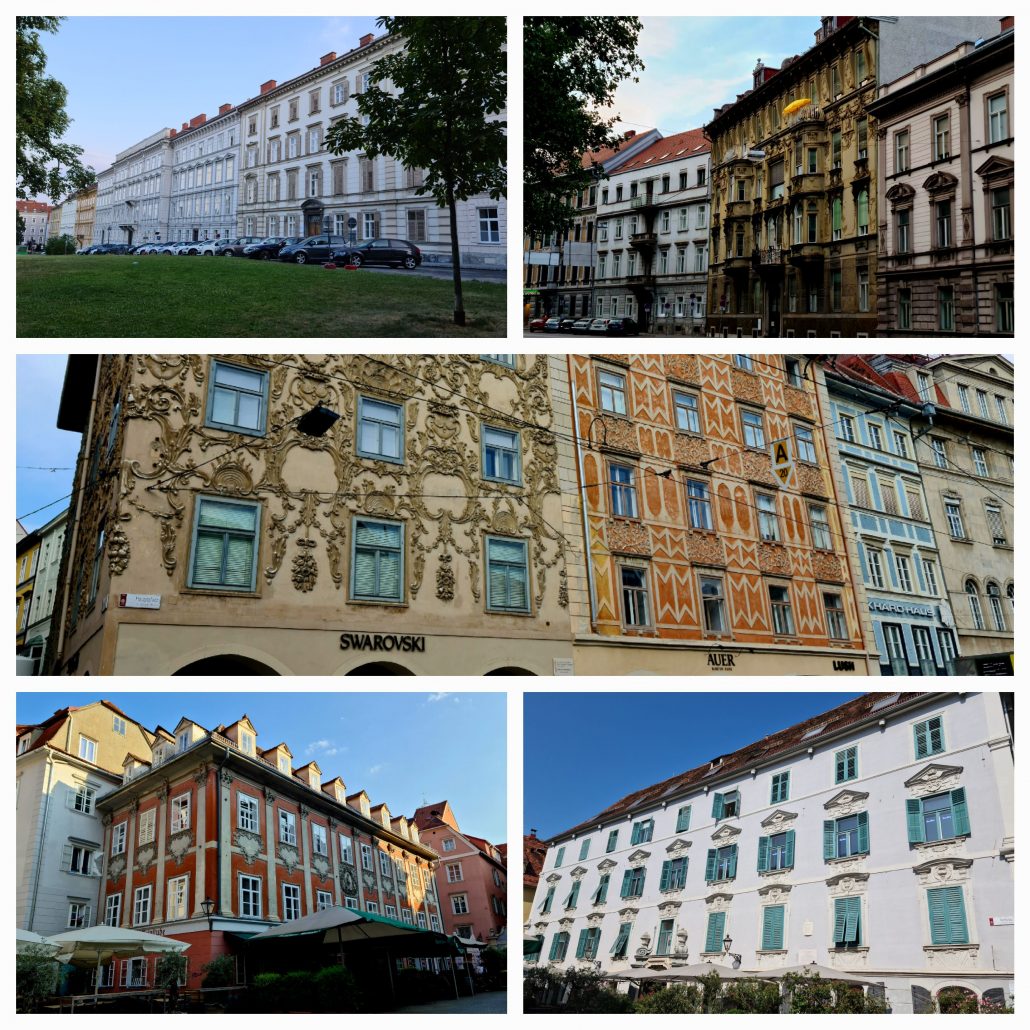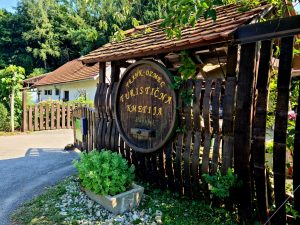I knew next to nothing about Graz before we visited. Until recently, it was only on my radar because it’s the hometown of one of my favourite musicians. When people on tour visit Austria, they make a beeline for Vienna. Understandable. It’s the capital. As cities go, they’re different. Very different. Vienna is the aunt in a pastel twinset and pearls who serves afternoon tea with crustless cucumber sandwiches. Stylish. Elegant. Stoic. Graz is the vegan aunt who dotes on her psychotherapist and dresses in bright colours. Vibrant. Colourful. Defiant.
Built Graz
The city is jaw-droppingly gorgeous. The old town sits on the site of a first-century Roman fort. More old money than new rich. The colours are muted shades of old-world wealth. The ornamentation is impressive. So much of old-town Graz seems to have survived the allied bombing of WWII despite it being the most frequently bombed city in Austria. Considering that Vienna was bombed some 52 times, Graz was lucky to escape with so much of its rich architecture still intact. The first city in the Ostmark (i.e. the name used by Nazi propaganda from 1938 to 1942 to replace that of the formerly independent Federal State of Austria after the Anschluss with Nazi Germany) to be declared free of Jews, there’s a history to the city that we will have to come back to explore.
I didn’t know, for instance, that Graz was of strategic importance as a central distribution point for fuel sent to other countries under the control of Nazi Germany. No wonder the Allies had it in their sights.

You can see the damage though, where old and new builds sit side by side. Mostly on the other side of the River Mur, across from the castle.

And it’s not all about old. There’s plenty going on by way of new stuff, too. Iconic stuff, like the Murinsel – Island in the Mur – an island café in the middle of the Mur river. Built in 2003, it’s the work of New York artist Vito Acconci. [I missed his Walkways through the Wall at the Wisconsin Center in Milwaukee.] Described by the artist as
“A bowl that morphs into a dome that morphs into a bowl…” Mur Island is in the form of a giant sea shell and measures 47 m (154 ft) in length. Two footbridges connect it with both banks of the Mur. The centre of the platform forms an amphitheatre. Below a twisted round dome there is a café and a playground.

And there’s the friendly alien, aka Kunsthaus Graz, Grazer Kunsthaus, or Graz Art Museum. Designed by Peter Cook and Colin Fournier, it has something in common with the Murinsel – both were commissioned for 2003 when Graz was the European Capital of Culture.

Sir Peter (he was knighted in 2007) was a founder member of Archigram
an avant-garde architectural group formed in the 1960s that was neofuturistic, anti-heroic and pro-consumerist, drawing inspiration from technology in order to create a new reality that was solely expressed through hypothetical projects.
The friendly alien is real, though the €26 million budget pales in comparison to Fournier’s
urbanistic mega project Yanbu, on the west coast of Saudi Arabia, with a population of 200 000 inhabitants and a total yearly construction budget of over 2 trillion US dollars.
If I had to pick two buildings, and given that I didn’t even make a dent in what there is to see, one of them would be the Italian Renaissance Landhaus, home of the Styrian Parliament in Graz. Built in 1527, its arched windows and courtyard of arcades are impressive.



The second was up by the university. Not so much the building but the story behind it. The Allenmann fraternity house.

Fraternity houses fascinate me. I’d always associated them with American universities though. I hadn’t realised they were also a European institution. The Fraternity Allemannia was founded in December 1869. They’re characterised by three qualities: friendship, the quality of a handshake, and diversity of opinion.
We Allemannen always question things critically and do not approach life with a backward-looking one-dimensionality. We remain inquisitive throughout our lives and avoid oversimplifying the world. We always try to act free-spirited in our work and to be an impeccable role model for others: “Noble be the human being, helpful and good” (Johann Wolfgang von Goethe).
Their website makes for fascinating reading. I wonder if they’re still exclusively male.
Built Graz is like a book of short stories. Some of the buildings, like this frat house, hint at what’s behind them. And it’s not alone. Signposts remain to an illustrious past.

In 1884 businessman Gottfried Maurer bought a house on what was then known as Florenzplatzl in the heart of Graz’s old town and had a carillon installed in it. In 1905, on Christmas Eve, the melody of 24 bells rang out for the first time.
Green Graz
Graz is a green city. I noticed within the first couple of hours the number of vegan restaurants (and the number of psychotherapists). Sustainability is a city-wide initiative with almost 100% buy-in from the residents.
Urban planning director Bertram Werle says that the crucial goal is the ‘City of short distances’, in which all daily needs are met are within walking distance. Graz is growing but there’s limited space, so the focus is on turning parts of the inner city, with its excellent infrastructure, into energy-efficient, resource-conserving, low-emission residential areas with a high quality of life. I Live Graz was a project defining Smart City goals for Graz in the areas of economy, society, ecology, mobility, energy, and facility management, aiming to provide appealing residential spaces alongside attractive public spaces and walking/cycling routes. This formed the basis for Smart City Project Graz Mitte, a new urban district created on a former industrial area near Graz’s main railway station. The project will involve low emission energy technologies, spaces for small businesses pioneering building technologies, demonstration facilities, and strategies for sustainable urban mobility, with the aim of making the area self-sufficient in energy and zero-emission. Citizens are actively encouraged to participate in development.
We didn’t use public transport – we walked everywhere. And loved it. Stadtpark has been around since 1870 and spans some 22 ha from the opera to the castle. Modelled on an English garden, it’s impressive that it has withstood the pressures of planning. The fountain is the work of French sculptor Jean-Baptiste-Jules Klagmann whose work is all over the Louvre.

Other Graz
The graffiti in the city is pretty mindless. I had read about some in a church courtyard that was worth checking out but it’s been painted over. Other than the motivational sayings printed on saucers I wasn’t that impressed by the scribbling. Still, though, a few signs caught my eye, suggesting that there’s movement afoot in the city.


We only saw a fraction of what’s to see. Graz is a city you could visit again and again, each time finding something new. In the words of one of its famous sons, I’ll be back. And yes, that’s top of my list next trip- a visit to the Arnie museum about 20 minutes from the city.
Arnie aside though, there’s a wealth of stories hidden behind the facades, and so much to learn from the past. Effectively we had a day and a half there but whatever magic time worked, it felt like a proper holiday. The mystery of Graz in action.
Additional reading
I flew the RAF bomber so he could storm the Nazi railyard: Elderly neighbours amazed to discover they both took part in the same WWII mission in Austria.
Yanbu, Saudi Arabia: A Traditional City in Transition.
Inside the secret fraternities of Germany and Austria.
Exploring the Bizarre, Offbeat & Unusual in Graz: 12 Alternative Things to Do
Notes for next time
Book a free tour
Check what’s showing at the Friendly Alien.
Visit the Landhaus for the advent ice nativity.
Check out the Mausoleum (open Sundays).
Go see Arnie.
Share this:
- Click to share on X (Opens in new window) X
- Click to share on Facebook (Opens in new window) Facebook
- Click to share on Pinterest (Opens in new window) Pinterest
- Click to share on LinkedIn (Opens in new window) LinkedIn
- Click to share on Reddit (Opens in new window) Reddit
- Click to share on WhatsApp (Opens in new window) WhatsApp
- Click to share on Pocket (Opens in new window) Pocket
- Click to share on Telegram (Opens in new window) Telegram
- Click to email a link to a friend (Opens in new window) Email








One Response